Lyons W.C. (ed.). Standard handbook of petroleum and natural gas engineering.2001- Volume 1
Подождите немного. Документ загружается.

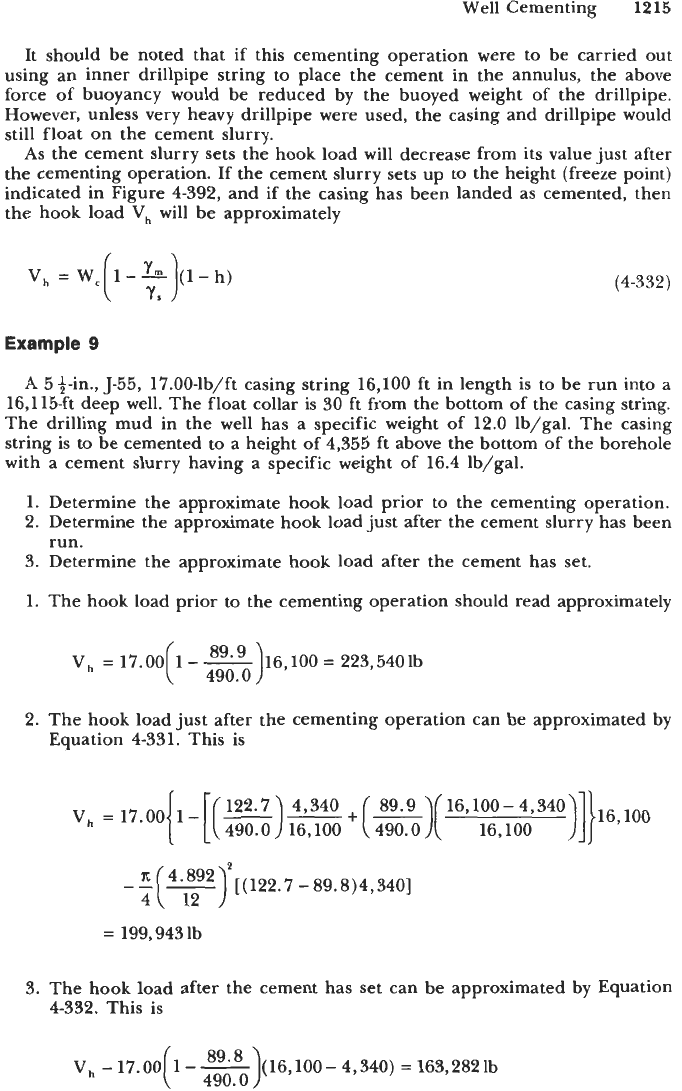
Well Cementing
1215
It should be noted that if this cementing operation were to be carried out
using an inner drillpipe string to place the cement in the annulus, the above
force of buoyancy would be reduced by the buoyed weight of the drillpipe.
However, unless very heavy drillpipe were used, the casing and drillpipe would
still float on the cement slurry.
As
the cement slurry sets the hook load will decrease from its value just after
the cementing operation. If the cement slurry sets up to the height (freeze point)
indicated in Figure 4-392, and if the casing has been landed as cemented, then
the hook load
V,
will be approximately
V,
=
W, 1-- (1-h)
(
;I
(4-332)
Example
9
A
5+-in., 5-55, 17.OO-lb/ft casing string 16,100 ft in length is to be run into a
16,115-ft deep well. The float collar is 30
ft
from the bottom of the casing string.
The drilling mud in the well has a specific weight of 12.0 lb/gal. The casing
string is to be cemented to a height of 4,355 ft above the bottom of the borehole
with a cement slurry having a specific weight of 16.4 lb/gal.
1.
Determine the approximate hook load prior to the cementing operation.
2. Determine the approximate hook load just after the cement slurry has been
3. Determine the approximate hook load after the cement has set.
1.
The hook load prior to the cementing operation should read approximately
run.
V,
=
17.00
(
1--
:~ig0)16,100
=
223,5401b
2.
The hook load just after the cementing operation can be approximated by
Equation 4-331. This is
V,
=
17.00
{
1-
[(
-
122.7)
-
4,340
+(
4"g"dgo)(
~~,100-4,3~0)]}16,100
490.0 16,100 16,100
-4(d
892
*[(122.7
-
89.8)4,340]
'
=
199,943 lb
3.
The hook load after the cement has set can be approximated by Equation
4-332. This is
V,
-17.00
(
1--
:~~80)(16,100- 4,340)
=
163,28211,

1216
Drilling and Well Completions
Multistage Casing Cementing
that multistage cementing techniques are necessary are as follows:
Multistage casing cementing is used to cement long casing strings. The reasons
reduce the pumping pressure of the cement pumping equipment;
reduce the hydrostatic pressure on weak formations to prevent fracture;
selected formations can be cemented;
entire length of a long casing string may be cemented;
casing shoe of the previous casing string may be effectively cemented to
the new casing string;
reduces cement contamination.
There are methods for carrying out multistage cementing. These are
1.
regular two-stage cementing
2.
continuous two-stage cementing
3.
regular three-stage cementing
Regular two-stage cementing requires the use of stage cementing collar and
plugs in addition to the conventional casing cementing equipment. The stage
cementing collar is placed in the casing string at near the mid point,
or
at a
position in the casing string where the upper cementing of the casing is to take
place. Figure
4-394
shows a schematic of a regular two-stage casing cementing
operation. The stage cementing collar is a special collar with ports to the
annulus that can be opened and closed (sealed off) by pressure operated sleeves
(see Figure
4-394).
The first stage of cementing (the lower section of the annulus) is carried out
similar to a conventional single-stage casing cementing operation. The exception
is that a wiper plug is generally not run in the casing prior to the spacer and
the cement slurry.* During the pumping of the spacer and cement slurry for
the lower section
of
the annulus, the ports on the stage cementing collar are
closed. After the appropriate volume of spacer and cement slurry has been
pumped to the well (lower section) the first stage plug is released. This plug is
pumped to its position on the float collar at the bottom of the casing string
with drilling mud or completion fluid as the displacement fluid. This first plug
is designed to pass through the stage cementing collar without actuating it. When
the first plug is landed on the float collar, there is a pressure rise at the pump.
This plug seals the float collar such that further flow throughout the collar
cannot take place.
After the first-stage cementing operation has been carried out the opening
bomb can be dropped and allowed to fall by gravity to the lower seal of the
stage cementing collar. This can be done immediately after the first-stage
cementing has taken place, or at some later time when the cement slurry in
the lower section
of
the
well
has had time to set. In the later case great care
must be taken that the first-stage cement slurry has not risen in the annulus to
a height above the stage cementing collar. Once the opening bomb is seated,
pump pressure is applied that allows hydraulic force to be applied to the lower
sleeve of the stage cementing collar. This force shears the lower sleeve retaining
pins and exposes the ports to the annulus.
*A
wiper plug may be accommodated
with
special equipment
[161].
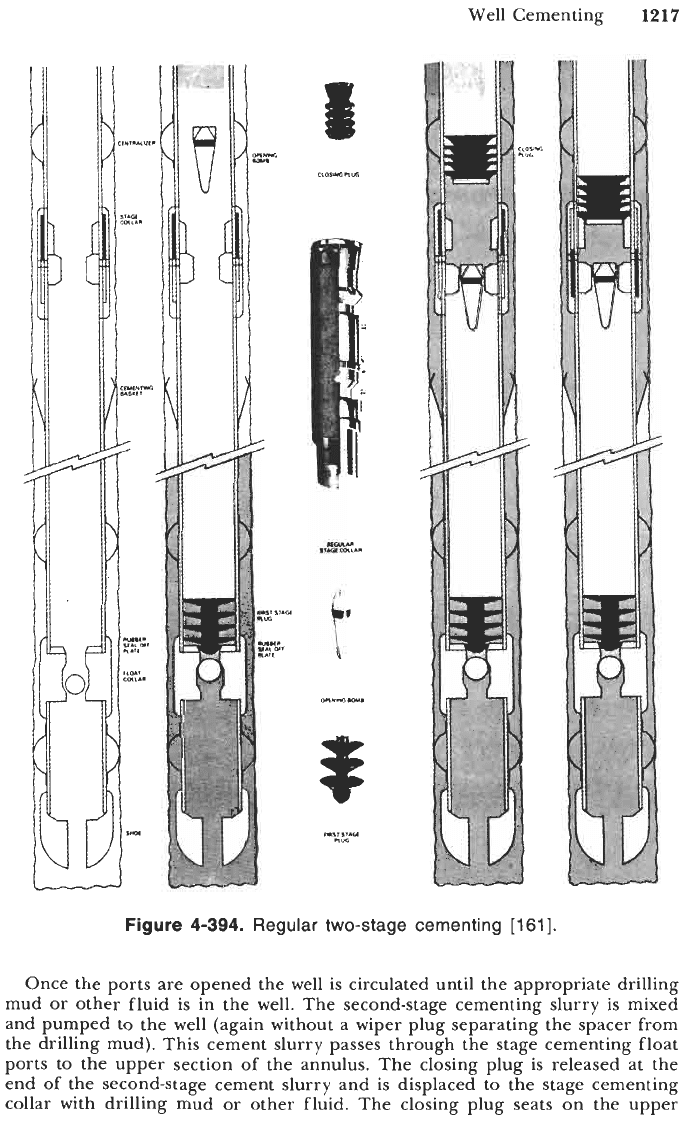
Well Cementing
1217
Figure
4-394.
Regular two-stage cementing
[I
611.
Once the ports are opened the well is circulated until the appropriate drilling
mud or other fluid is in the well. The second-stage cementing slurry is mixed
and pumped to the well (again without a wiper plug separating the spacer from
the drilling mud). This cement slurry passes through the stage cementing float
ports to the upper section of the annulus. The closing plug is released at the
end of the second-stage cement slurry and is displaced to the stage cementing
collar with drilling mud or other fluid. The closing plug seats on the upper
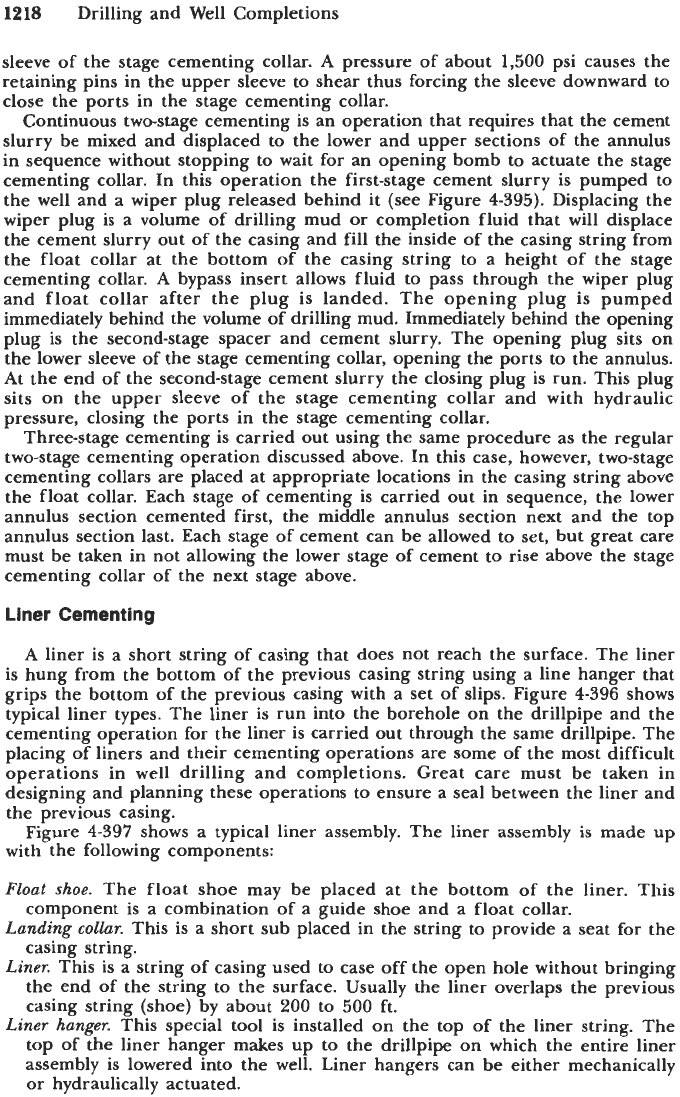
1218
Drilling and Well Completions
sleeve of the stage cementing collar.
A
pressure of about
1,500
psi causes the
retaining pins in the upper sleeve to shear thus forcing the sleeve downward to
close the ports in the stage cementing collar.
Continuous two-stage cementing is an operation that requires that the cement
slurry be mixed and displaced to the lower and upper sections of the annulus
in sequence without stopping to wait for an opening bomb to actuate the stage
cementing collar. In this operation the first-stage cement slurry is pumped to
the well and a wiper plug released behind it (see Figure
4-395).
Displacing the
wiper plug is
a
volume of drilling mud or completion fluid that will displace
the cement slurry out of the casing and fill the inside of the casing string from
the float collar at the bottom of the casing string to a height of the stage
cementing collar.
A
bypass insert allows fluid to pass through the wiper plug
and float collar after the plug is landed. The opening plug is pumped
immediately behind the volume of drilling mud. Immediately behind the opening
plug is the second-stage spacer and cement slurry. The opening plug sits on
the lower sleeve of the stage cementing collar, opening the ports to the annulus.
At the end of the second-stage cement slurry the closing plug is run. This plug
sits on the upper sleeve of the stage cementing collar and with hydraulic
pressure, closing the ports in the stage cementing collar.
Three-stage cementing is carried out using the same procedure as the regular
two-stage cementing operation discussed above. In this case, however, two-stage
cementing collars are placed at appropriate locations in the casing string above
the float collar. Each stage of cementing is carried out in sequence, the lower
annulus section cemented first, the middle annulus section next and the top
annulus section last. Each stage of cement can be allowed to set, but great care
must be taken in not allowing the lower stage of cement to rise above the stage
cementing collar of the next stage above.
Liner Cementing
A liner is a short string of casing that does not reach the surface. The liner
is hung from the bottom of the previous casing string using a line hanger that
grips the bottom of the previous casing with a set of slips. Figure
4-396
shows
typical liner types. The liner is run into the borehole on the drillpipe and the
cementing operation for the liner is carried out through the same drillpipe. The
placing of liners and their cementing operations are some of the most difficult
operations in well drilling and completions. Great care must be taken in
designing and planning these operations to ensure a seal between the liner and
the previous casing.
Figure
4-397
shows
a
typical liner assembly. The liner assembly is made
up
with the following components:
noat
shoe.
The float shoe may be placed at the bottom of the liner. This
component is a combination of a guide shoe and a float collar.
Landing
collar.
This is a short sub placed in the string to provide a seat for the
casing string.
Liner.
This is a string
of
casing used
to
case off the open hole without bringing
the end of the string to the surface. Usually the liner overlaps the previous
casing string (shoe) by about
200
to
500
ft.
Liner hanger.
This special tool
is
installed on the top of the liner string. The
top of the liner hanger makes up to the drillpipe on which the entire liner
assembly is lowered into the well. Liner hangers can be either mechanically
or hydraulically actuated.
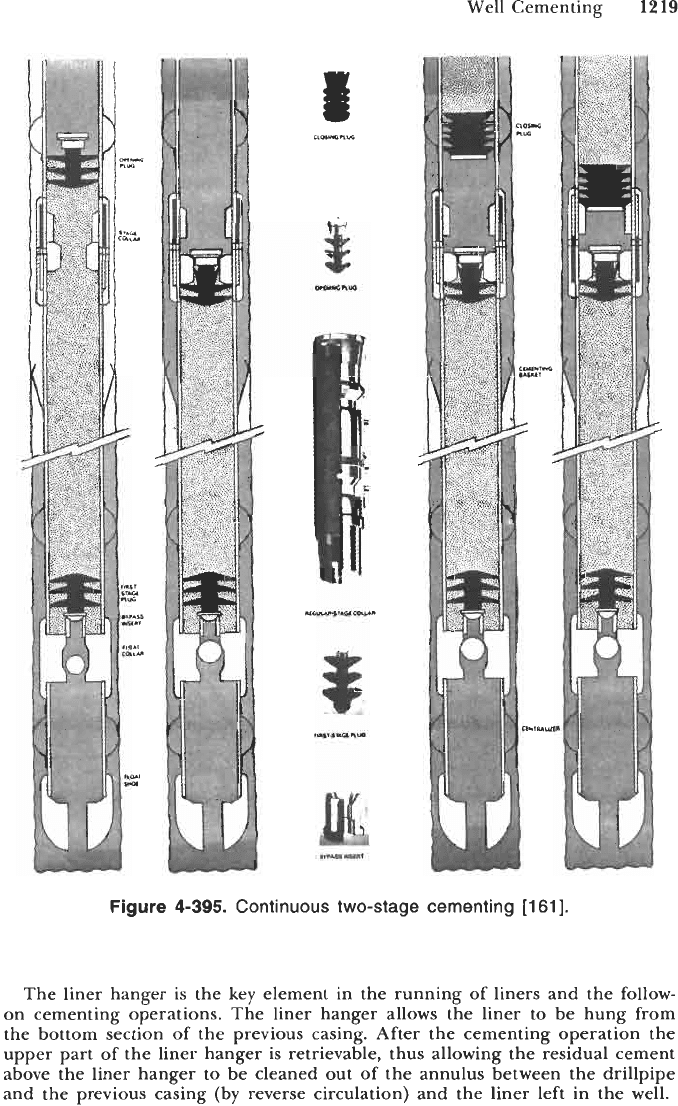
Well Cementing
1219
Figure
4-395.
Continuous two-stage cementing
[161].
The liner hanger is the key element in the running of liners and the follow-
on cementing operations. The liner hanger allows the liner to be hung from
the bottom section of the previous casing. After the cementing operation the
upper part of the liner hanger is retrievable, thus allowing the residual cement
above the liner hanger to be cleaned out of the annulus between the drillpipe
and the previous casing (by reverse circulation) and the liner left in the well.
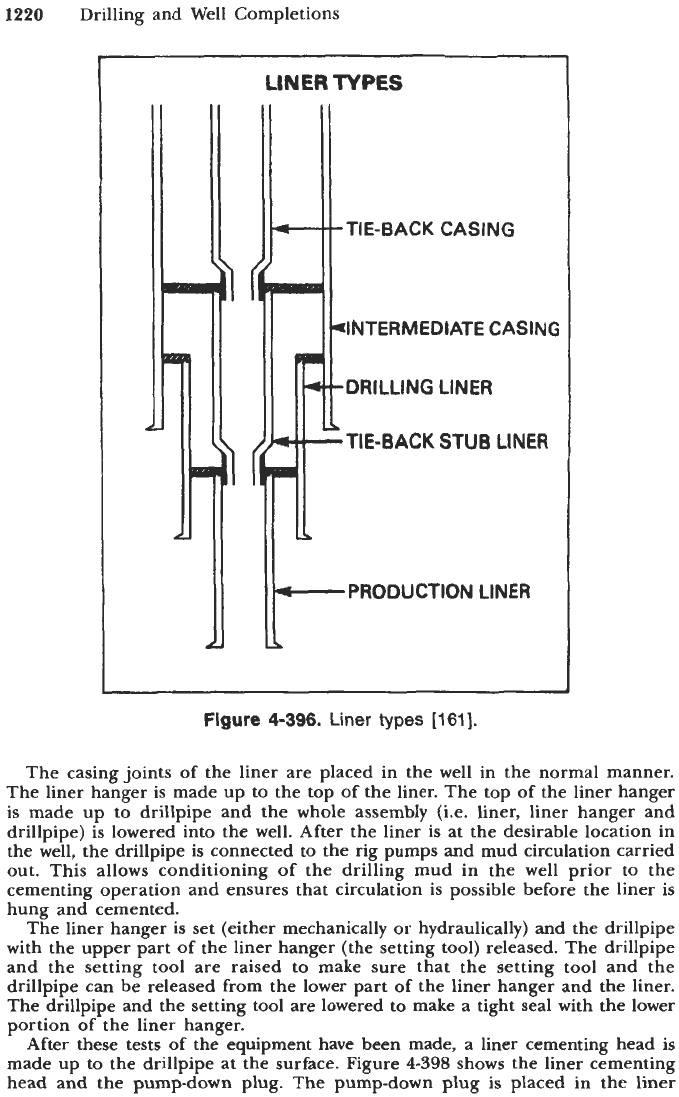
1220
Drilling and Well Completions
LINER
TYPES
i
1
.TIE-BACK CASING
4NTERMEDIATE CASING
-DRILLING LINER
PRO
DU CTlON LINER
r-
Figure
4-396.
Liner
types
[161].
The casing joints of the liner are placed in the well in the normal manner.
The liner hanger is made up to the top of the liner. The top of the liner hanger
is made up to drillpipe and the whole assembly (Le. liner, liner hanger and
drillpipe) is lowered into the well. After the liner is at the desirable location in
the well, the drillpipe is connected to the rig pumps and mud circulation carried
out. This allows conditioning
of
the drilling mud in the well prior to the
cementing operation and ensures that circulation is possible before the liner is
hung and cemented.
The liner hanger is set (either mechanically or hydraulically) and the drillpipe
with the upper part of the liner hanger (the setting tool) released. The drillpipe
and the setting tool are raised to make sure that the setting tool and the
drillpipe can be released from the lower part of the liner hanger and the liner.
The drillpipe and the setting tool are lowered to make a tight seal with the lower
portion of the liner hanger.
After these tests
of
the equipment have been made, a liner cementing head is
made up
to
the drillpipe at the surface. Figure
4-398
shows the liner cementing
head and the pump-down plug. The pump-down plug
is
placed in the liner
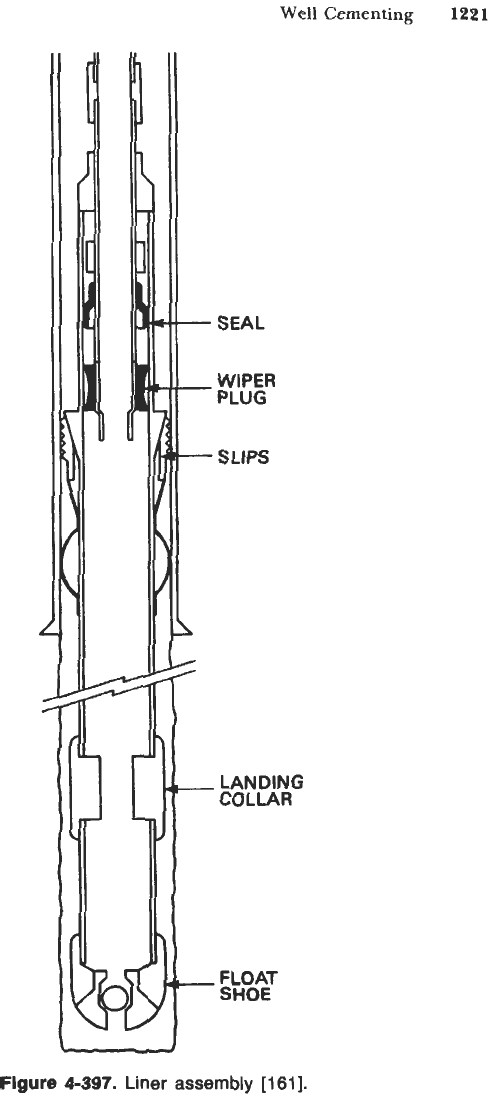
Well
Cementing
1221
-
SEAL
-
WIPER
PLUG
SLIPS
I
I
LANDING
COLLAR
I
FLOAT
I
SHOE
-
Flgure
4-397.
Liner
assembly
[161].
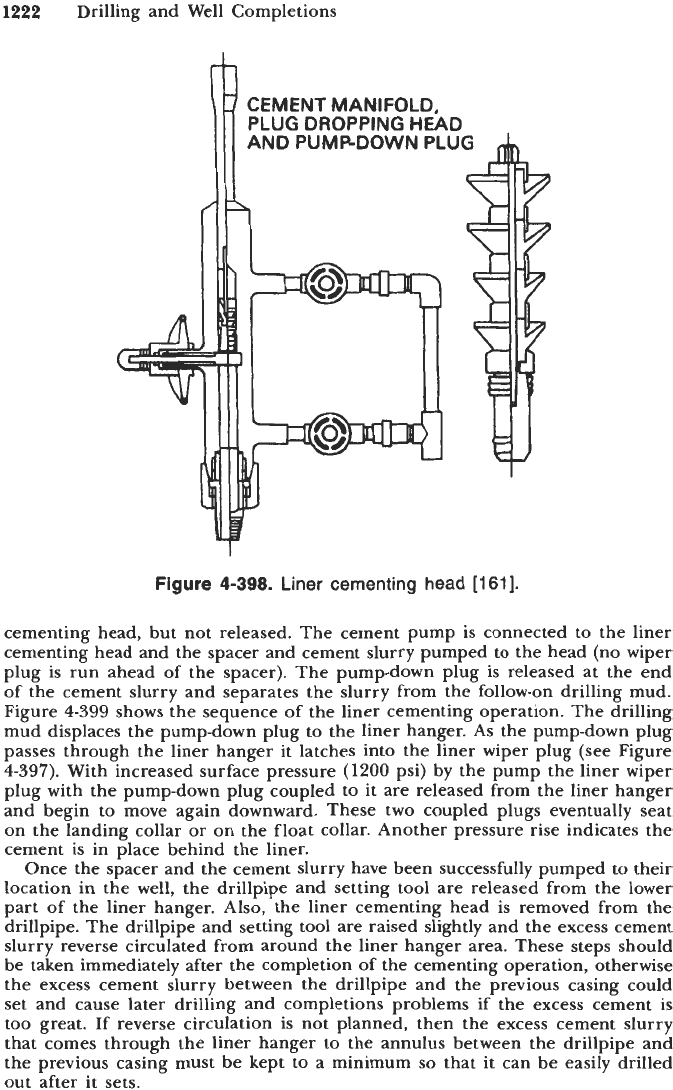
1222
Drilling and Well Completions
CEMENT MANIFOLD,
PLUG DROPPING
HEAD
AND
PUMPDOWN PLUG
Figure
4-398.
Liner cementing head
[l
611.
cementing head, but not released. The cement pump is connected to the liner
cementing head and the spacer and cement slurry pumped to the head (no wiper
plug is run ahead
of
the spacer). The pump-down plug is released at the end
of the cement slurry and separates the slurry from the follow-on drilling mud.
Figure
4-399
shows the sequence of the liner cementing operation. The drilling
mud displaces the pump-down plug to the liner hanger. As the pump-down plug
passes through the liner hanger it latches into the liner wiper plug (see Figure
4-397).
With increased surface pressure
(1200
psi) by the pump the liner wiper
plug with the pump-down plug coupled to
it
are released from the liner hanger
and begin to move again downward. These two coupled plugs eventually seat
on the landing collar or on the float collar. Another pressure rise indicates the
cement is in place behind the liner.
Once the spacer and the cement slurry have been successfully pumped to their
location in the well, the drillpipe and setting tool are released from the lower
part of the liner hanger. Also, the liner cementing head is removed from the
drillpipe. The drillpipe and setting tool are raised slightly and the excess cement
slurry reverse circulated from around the liner hanger area. These steps should
be taken immediately after the completion of the cementing operation, otherwise
the excess cement slurry between the drillpipe and the previous casing could
set and cause later drilling and completions problems if the excess cement is
too great.
If
reverse circulation is not planned, then the excess cement slurry
that comes through the liner hanger
to
the annulus between the drillpipe and
the previous casing must be kept to a minimum
so
that it can be easily drilled
out after it sets.
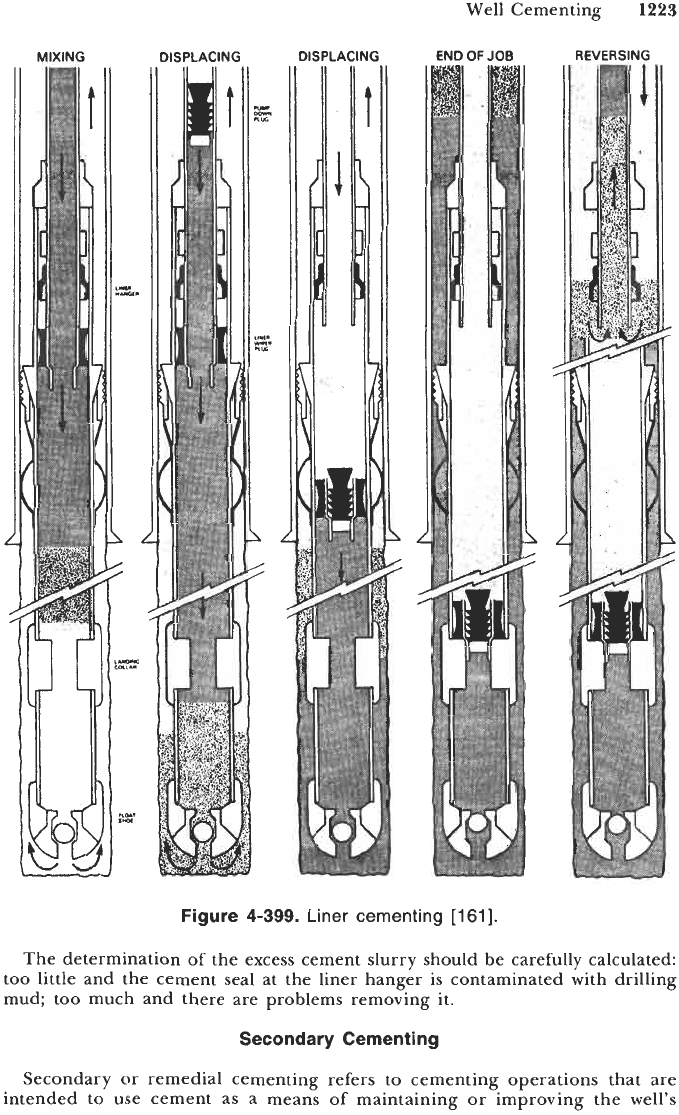
Well Cementing
1223
MIXING
DISPLACING
DISPLACING
END
OF
JOB
REVERSING
Figure
4-399.
Liner cementing
[161].
The determination of the excess cement slurry should be carefully calculated:
too little and the cement seal at the liner hanger is contaminated with drilling
mud; too much and there are problems removing it.
Secondary Cementing
Secondary or remedial cementing refers to cementing operations that are
intended to use cement as a means of maintaining or improving the well’s
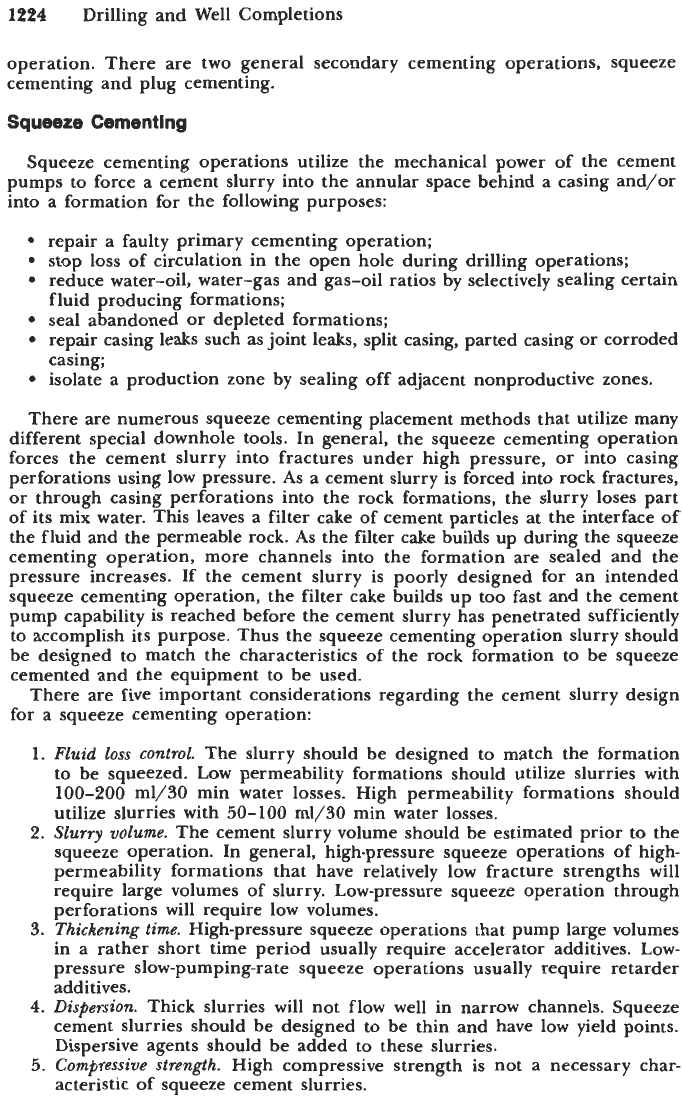
1944
Drilling and Well Completions
operation. There are two general secondary cementing operations, squeeze
cementing and plug cementing.
Squeeze Cementing
Squeeze cementing operations utilize the mechanical power of the cement
pumps to force a cement slurry into the annular space behind a casing and/or
into a formation for the following purposes:
repair a faulty primary cementing operation;
stop loss of circulation in the open hole during drilling operations;
reduce water-oil, water-gas and gas-oil ratios by selectively sealing certain
fluid producing formations;
seal abandoned or depleted formations;
repair casing leaks such as joint leaks, split casing, parted casing or corroded
casing;
isolate a production zone by sealing off adjacent nonproductive zones.
There are numerous squeeze cementing placement methods that utilize many
different special downhole tools. In general, the squeeze cementing operation
forces the cement slurry into fractures under high pressure, or into casing
perforations using low pressure.
As
a cement slurry is forced into rock fractures,
or
through casing perforations into the rock formations, the slurry loses part
of its mix water. This leaves a filter cake of cement particles at the interface of
the fluid and the permeable rock.
As
the filter cake builds up during the squeeze
cementing operation, more channels into the formation are sealed and the
pressure increases. If the cement slurry is poorly designed for an intended
squeeze cementing operation, the filter cake builds up too fast and the cement
pump capability is reached before the cement slurry has penetrated sufficiently
to accomplish its purpose. Thus the squeeze cementing operation slurry should
be designed to match the characteristics of the rock formation to be squeeze
cemented and the equipment to be used.
There are five important considerations regarding the cement slurry design
for a squeeze cementing operation:
1.
Fluid
loss
control.
The slurry should be designed to match the formation
to be squeezed. Low permeability formations should utilize slurries with
100-200
m1/30 min water losses. High permeability formations should
utilize slurries with
50-100
m1/30 min water losses.
2.
Slurry
volume.
The cement slurry volume should be estimated prior to the
squeeze operation. In general, high-pressure squeeze operations of high-
permeability formations that have relatively low fracture strengths will
require large volumes of slurry. Low-pressure squeeze operation through
perforations will require low volumes.
3.
Thickening time.
High-pressure squeeze operations that pump large volumes
in a rather short time period usually require accelerator additives. Low-
pressure slow-pumping-rate squeeze operations usually require retarder
additives.
4.
Dispersion.
Thick slurries will not flow well in narrow channels. Squeeze
cement slurries should be designed to be thin and have low yield points.
Dispersive agents should be added to these slurries.
5.
Compressive strength.
High compressive strength is not a necessary char-
acteristic of squeeze cement slurries.
